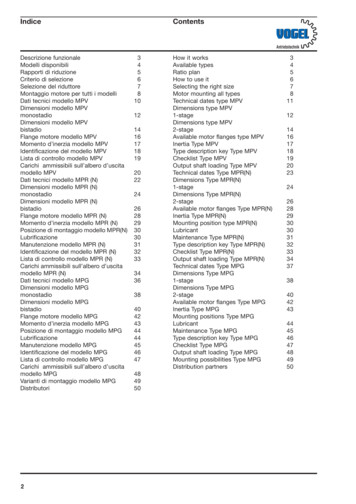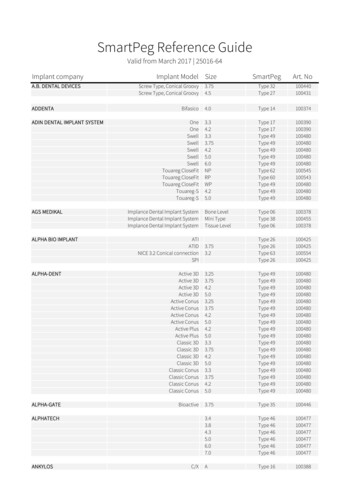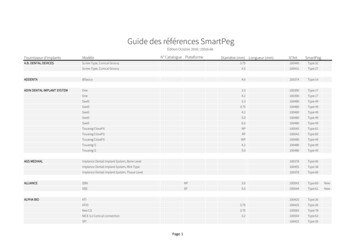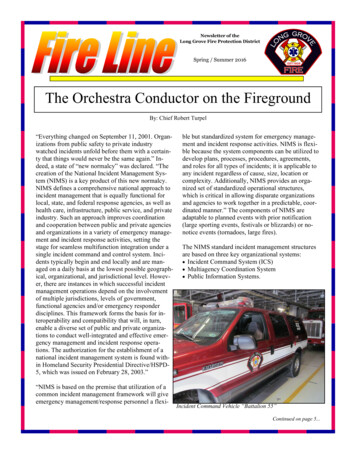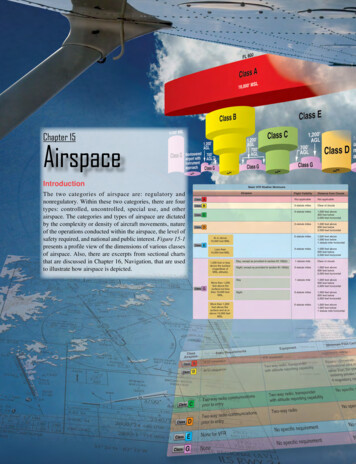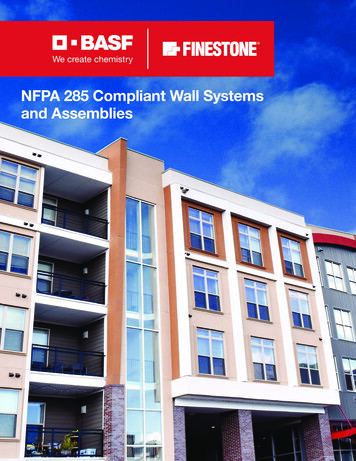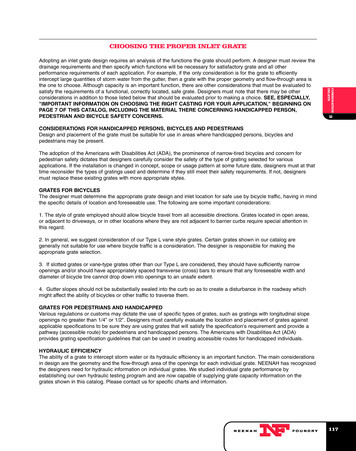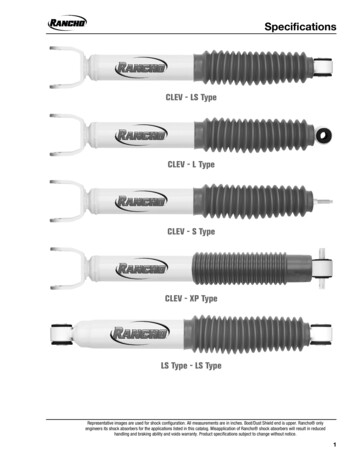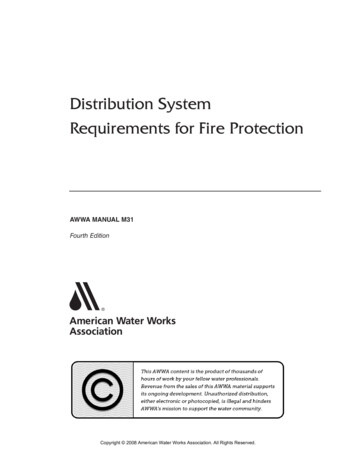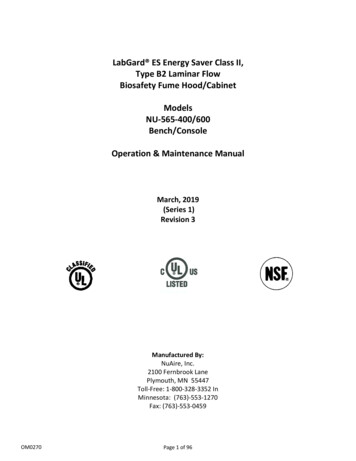
Transcription
LabGard ES Energy Saver Class II,Type B2 Laminar FlowBiosafety Fume tion & Maintenance ManualMarch, 2019(Series 1)Revision 3Manufactured By:NuAire, Inc.2100 Fernbrook LanePlymouth, MN 55447Toll-Free: 1-800-328-3352 InMinnesota: (763)-553-1270Fax: (763)-553-0459OM0270Page 1 of 96
Congratulations!You have just purchased one of the finest Laminar Flow Biosafety Fume Hood/Cabinets available. With proper care,maintenance (certification), and laboratory procedure, this cabinet will give you years of product and personnel protection fromparticulate contaminants as prescribed in NSF/ANSI 49 and ASHRAE 110. Please read this manual carefully to familiarize you withproper installation, maintenance and operation of the cabinet. Other reference and guideline materials are available through thefollowing web /www.nuaire.comOM0270March/2019Page 2 of 96
ABOUT THIS OPERATION & MAINTENANCE MANUALThe information contained in this manual is intended to reflect our current production standard configuration model alongwith the more frequently purchased options. Any unique additions/modifications/shop drawings are appended in the back flap ofthis manual, along with any modifications and/or additions to procedures as outlined in this manual. A copy of the original factorytest report is also appended to this manual. In case this manual and/or test report is lost or misplaced, NuAire retains a copy in ourfiles. A replacement copy can be obtained by calling or writing NuAire, Inc. stating the model number and serial number and a briefdescription of the information desired.OM0270March/2019Page 3 of 96
LabGard ES Energy Saver Class II, Type B2 Laminar Flow Biosafety Fume Hood/CabinetModels NU-565-400/600 Operation & Maintenance ManualTABLE OF CONTENTSSection No. 1 . General InformationSection No. 2 . Models & FeaturesSection No. 3 . Warranty DisclaimerSection No. 4 . ShipmentsSection No. 5 . Installation Instructions5.1 .Location5.2 .Set-up Instructions5.3 .Exhaust/Supply Air Checks5.4 .Certification Testing Methods and EquipmentSection No. 6 . Operating the NU-5656.1 .Biosafety Cabinet Control6.2 .Operating Guidelines6.3 .Operating Sequence6.4 .Ergonomics6.5 .Cleaning Procedures6.6 .Hazardous Drug Decontamination ProcedureSection No. 7 . General Maintenance7.1 .Decontamination7.2 .LED Lamp Bulb Replacement7.3 .HEPA Filter/Motor Replacement7.4 .Sliding Window Replacement & Adjustment7.5 .Airflow Control System Setup & Calibration7.6 .HEPA Filter Leak Test7.7 .Airflow Smoke Pattern Test7.8 .Site Installation Assessment Tests7.9 .Cleanliness Classification Test for Pharmacy Application7.10 .Main Control Board Description & Replacement7.11 .Digital Airflow Sensor Description & ReplacementSection No. 8 . Error Indicators, Troubleshooting, Option-Diagnostics &Airflow Sensor Performance VerificationSection No. 9 . Remote ContactsSection No. 10 . Electrical/Environmental RequirementsSection No. 11 . Disposal and RecycleInsert . Replacement Parts List & WarrantyMANUAL DRAWINGSACD-19028 . NU-565 Airflow SchematicBCD-20051. NU-565-400 Specification DrawingBCD-20052. NU-565-600 Specification DrawingBCD-16300. Drain Valve InstallationBCD-05572. Butterfly Valve InstallationBCD-05660. Bag In/Bag Out ProcedureASSEMBLY DRAWINGSBCD-16633. Base Stand AssemblyBCD-19031. Control Center & Front Decorative Panel AssemblyBCD-16376. Sliding Window Assembly & AdjustmentBCD-19032. Base Cabinet AssemblyELECTRICAL SCHEMATICSBCD-19033 (Sheets 1-2) . NU-565-400/600 Electrical SchematicOM0270March/2019Page 4 of 96
LabGard ES Energy Saver Class II,Type B2 Laminar FlowBiosafety Fume Hood/CabinetModelsNU-565-400/600MANUFACTURED BY:NuAire, Inc. - Plymouth, Minnesota, U.S.A.1.0General Information1.1 DescriptionThe LABGARD ES Model NU-565 Laminar Flow Biosafety Fume Hood/Cabinet is a bench/table top model, optionallyavailable with a base support stand, for operation as a console model. The LABGARD ES model NU-565 utilizes an EnergySaver DC ECM motor optimally determined forward curved fan for each model size/width to maximize both energyefficiency and filter loading capacity. The Energy Saver ECM motor is controlled to airflow setpoints via a solid-state DCmotor controller with digital dual thermistor airflow sensors that provide an automatic compensation (constant volumecontrol) for both filter loading and line voltage variances.The Laminar Flow Biosafety Fume Hood/Cabinet, is a product resulting from the development of the "laminar flow"principle and the application of environmental controls as required in the field of biological research or chemicalcontainment. The Biosafety Fume Hood/Cabinet, when used with proper technique, is an effective laboratory aid inobtaining the optimum control over product quality while reducing the potential for exposure of both product andpersonnel to airborne biological or particulate chemical agents in low to moderate risk-hazard research and drugpreparation or product operations, as prescribed by the Center for Disease Control (CDC) Atlanta, Georgia.The NU-565 Bench meets the requirements of a Class II, Type B2 since the cabinet conforms to the followingrequirements:-Maintain a minimum average inflow velocity of 100 fpm (0.51m/s) through the work access opening;-Have HEPA filtered downflow air drawn from the laboratory or the outside air (i.e. downflow air is not re-circulatedfrom the cabinet exhaust air;-Exhaust all inflow and downflow air to the atmosphere through a hard connection to the facility exhaust system afterfiltration through a HEPA filter without recirculation in the cabinet or return to the laboratory;-Have all contaminated ducts and plenums under negative pressure or surrounded by directly exhausted(non-re-circulated through the work area) negative pressure ducts and plenums.Type B2 Biosafety Fume Hood/Cabinet classified to UL 1805 may be used for work with flammable or volatile chemicals andradionuclides required if permitted by chemical risk assessment.OM0270March/2019Page 5 of 96
1.2 Safety InstructionsThese safety instructions describe the safety features of the LABGARD ES Model NU-565The Biosafety Fume Hood/Cabinet has been manufactured using the latest technological developments and has beenthoroughly tested before delivery. However, the cabinet may present potential hazards if it is not installed and used asinstructed for its intended purpose or outside of operating parameters. Therefore, the following procedures must alwaysbe observed: The Biosafety Fume Hood/Cabinet must be operated only by trained and authorized personnel. For any operation of this cabinet, the operator must prepare clear and concise written instructions for operatingand cleaning, utilizing applicable safety data sheets, plant hygiene guidelines, and technical regulations, inparticular.o Which decontamination measures are to be applied for the cabinet and accessories?o Which protective measures apply while specific agents are used?o Which measures are to be taken in the case of an accident? Repairs to the device must be carried out only by trained and authorized expert personnel. Keep these operating instructions close to the cabinet so that safety instructions and important information arealways accessible. Should you encounter problems that are not detailed adequately in the operating instructions, please contact yourNuAire Representative of NuAire technical Services.1.3 Explanation of Symbols! WARNINGCAUTION!CAUTIONSafety alert symbol indicates a potentially hazardoussituation which, if not avoided, could result in deathof serious injury.Safety alert symbol indicates a potentially hazardoussituation which, if not avoided, may result in minor ormoderate injury.CAUTION used without the safety alert symbolindicates a potentially hazardous situation which, ifnot avoided, may result in property damage.Potential electrical hazard, only qualified personto access. NOTE:Used for important information.Flammable HazardBiohazardHazardous Gases! PersonalProtection EquipmentRequired.Ground, EarthChemical HazardLead FreeOM0270March/2019Page 6 of 96
OM0270March/2019Page 7 of 96
2.0Models & FeaturesThe model NU-565, LABGARD ES Class II, Type B2 Laminar Flow Biosafety Fume Hood/Cabinet is manufactured in twosizes:4 ft. (1.2m) and 6 ft. (1.8m).OM0270March/2019Page 8 of 96
OM0270March/2019Page 9 of 96
OM0270March/2019Page 10 of 96
3.0WarrantyDetails regarding product warranties can be found in the published warranty data separate from this manual and includedwithin the data packet sent with the unit.4.0ShipmentsNuAire takes every reasonable precaution to assure that your LABGARD ES cabinet arrives without damage. Motorcarriers are carefully selected and shipping cartons have been specially designed to insure your purchase. However,damage can occur in any shipment and the following outlines the steps you should take on receipt of a NuAire LABGARD ES cabinet to be sure that if damage has occurred, the proper claims and actions are taken immediately.4.1 Damaged Shipments4.1.1Terms are factory, unless stated otherwise. Therefore, it is important to check each shipment before acceptance.4.1.2If there is visible damage, the material can be accepted after the driver makes a notation on the consignee's copyof the freight bill. Then an inspection must be made to verify the claim against the carrier. This inspection is thebasis of your filing the claim against the carrier.4.1.3If concealed damage is found it is absolutely necessary to NOTIFY THE FREIGHT AGENT AT ONCE and request aninspection. Without this inspection, the transportation company may not accept a claim for loss or damage. If thecarrier will not perform the inspection, an affidavit must be prepared stating that he was contacted on a certaindate and that he failed to comply with the request. This along with other papers in the customer's possession willsupport the claim.OM0270March/2019Page 11 of 96
5.0Installation Instructions5.1 LocationWithin the laboratory, pharmacy, etc., the ideal location of the Biosafety cabinet is away from personnel traffic lanes, airvents (in or out), doors and/or any other source of disruptive air currents.If drafts or other disruptive air currents exceed the inflow velocity of the cabinet through the access opening, the potentialexists for contaminated air to exit or enter the work zone area of the cabinet. It depends on the severity of the air current.REMEMBER: A BIOSAFETY CABINET IS NO SUBSTITUTE FOR GOOD LABORATORY TECHNIQUE.Where space permits, a clear 6 inch (152mm) area should be permitted on each side of the cabinet for maintenancepurposes. The electrical outlet into which the cabinet is connected should be readily accessible for maintenance purposes.Do not position the cabinet to prevent access to the power cord. The power cord plug serves as the disconnect andshould remain readily accessible. If the outlet is inaccessible, such as a conduit (hardwired) connection, then an appropriatewarning label should be applied near the cabinet's on/off switch, to indicate the circuit breaker on the power distributionpanel to be used.More than any other Biosafety cabinet, the NU-565 requires careful site-planning and preparation, due to the total exhaustnature of the cabinet. Proper sizing of the exhaust and make up supply systems are critical to the successful installation ofthe cabinet. In addition, the cabinet provides for the choice of make-up air for the supply (downflow) air. The following areairflow requirements based on concurrent balance values*.Air Volume (CFM/CMH)NU-565-400NU-565-600Supply Air544 / 924865 / 1470Inflow271 / 461410 / 697Exhaust Air**815 / 13851275 / 2166*Concurrent Balance Value is determined by a duct traverse measurement method as specified in ASHRAE Standard 111 atits nominal setpoint calibrated using the primary DIM method and capture hood removed. These values shall be used fordesign and balance exhaust/supply HVAC requirements.**Exhaust air volume at negative 1.7 inches (43mm) w.g. for NU-565-4001.8 inches (46mm) w.g. for NU-565-600OM0270March/2019Page 12 of 96
5.2 Set-Up InstructionsRemove outer shipping protection (carton or crating). The cabinet is fastened to the base skid and it is usually the bestprocedure to leave the skid in place until the cabinet is located in its approximate position to facilitate ease in handling.It can then be removed from the skid by removing the banding holding the cabinet to the skid. It may be necessary toremove the Control Center in order to gain passage through a doorway. It may easily be removed by following theinstructions on drawing BCD-19031.!5.2.1CAUTIONIt is recommended that no less than two people are present using alifting system for placement of the cabinet onto the base stand.It is not recommended to manually lift the cabinet onto the base stand.Base Stand AssemblyThe base stand is shipped knocked down in a separate carton and is assembled per drawing BCD-16633 ifaccompanied with the cabinet. Remove the banding holding the cabinet to the base skid. Lift the cabinet from thebase skid and place on the floor. Now lift the cabinet on top of the base and bolt the base stand to the cabinetusing two 3/8" - 16 x 3/4" bolts and washers provided for the front base stand tabs and two 1/4" acorn nuts for therear weld studs. Place the cabinet in its desired location.The base stand storage cabinets will usually be shipped according to customer requirements. If it is shippedunassembled, it can be assembled per drawing BCD-16633. It is recommended that the upper and lower basestand braces be installed first, then the rear and bottom panels (the end panels are always prefastened). Onceassembled, fasten the cabinet per the above instructions.Remove the cap protecting the drain valve threads and install the drain valve, on the bottom right front of thecabinet using Loctite 242 furnished to the threads and rotate the valve body until it is secure (See BCD-16300).5.2.2LevelingUsing a level placed on the work tray, adjust the leg levelers, first, end-to-end then front to back.The NSF approved leg levelers provide a 3/4" (20mm) adjustment.5.2.3Bench Installation (BCD-16300)Place the cabinet on the bench with approximately a 2" (51mm) overhang clearance for installation of the drainvalve. If the drain valve is not desired, cap with 3/8” NPT fitting and place the cabinet in its desired location andusing RTV caulk, seal all around the base of the cabinet and the bench. This provides a tight seal to prevent benchspills from migrating under the cabinet.If a drain valve is desired, (NOTE, CHECK WITH YOUR SAFETY PERSONNEL FOR REQULATORY REQUIREMENTS (i.e.LOCKING TYPE) OF DRAIN VALVE INSTALLATION) remove the handle from the valve stem to gain clearance forvalve body rotation. Add Loctite 242 (furnished) to the threads and rotate valve body until secure, with the valvestem (for handle) on the left side. Re-install handle to valve stem. Adjust the cabinet on bench to provide a1-1/2" (38mm) overhang and seal the interface of the bench and cabinet, using RTV caulk as above.OM0270March/2019Page 13 of 96
5.2.4Gas ServiceNuAire doesn't recommend the use of natural gas within the Biosafety Fume Hood/Cabinet, but if gas service isdetermined to be necessary for the application, appropriate safety measures must take place.Once the appropriate safety personnel have made the determination, the application of natural gas mustbe performed in accordance to national, state and local codes. IT IS ALSO STRONGLY RECOMMENDED THAT ANEMERGENCY GAS SHUTOFF VALVE BE PLACED JUST OUTSIDE THE BIOSAFETY FUME HOOD/CABINET ON THE GASSUPPLY LINE.All NuAire Biosafety Fume Hood/Cabinet's meet the safety requirements of UL 16010-1 for Laboratory Equipment.To comply with these safety requirements, NuAire uses only certified gas valves. In addition, if external piping isrequired, only black pipe is used for this application.As previously stated NuAire doesn't recommend the use of natural gas within the Biosafety Fume Hood/Cabinetand ASSUMES NO RESPONSIBILITY FOR ITS USE. USE AT YOUR OWN RISK. The Bunsen burner flame within theBiosafety Fume Hood/Cabinet not only contributes to heat build-up; is also disrupts the laminar air stream, whichmust be maintained for maximum efficiency. IF THE PROCEDURE DEMANDS USE OF A FLAME, A BUNSEN BURNERWITH ON DEMAND IGNITION IS STRONGLY RECOMMENDED. DO NOT USE CONSTANT FLAME GAS BURNERS.During use, the Bunsen burner should be placed to the rear of the workspace where resulting air turbulence willhave a minimal effect.5.2.5Plumbing ServicesRemote controlled needle-valve plumbing fixtures are provided within the interior sidewalls. Control handles arelocated externally on the vertical airfoil. Service outlets within the interior have serrated tapered fittings designedfor hose connections with the remote controlled needle valve plumbing fixtures. NuAire provides for rear, bottom,or top connections of plumbing services to plant utilities. Connection from the needle valve assembly to thewelded exit coupling is accomplished with the supplied 3/8 inch soft copper tubing as standard (alternativematerials to meet local codes are available upon request). The needle valves are not recommended for workingpressure in excess of 125 p.s.i. (8.6 BAR).5.2.6Electrical ServicesThe NU-565 series Biosafety Cabinets may be "hardwired" (optional) or plugged into an outlet with protectiveearthing connection with the standard power cord. The cabinet requires 115VAC, 60Hz single phase (correct ratingvaries per cabinet size, reference Electrical/Environmental Requirements). It is recommended that power to thecabinet, whether hardwired or plug connected, be on its own branch circuit, protected with a circuit breaker at thedistribution panel near the cabinet. A surge protector is strongly recommended if you are experiencing powerrelated faults.PLEASE NOTE THIS CABINET CONTAINS ELECTRONIC BALLASTS FOR THE LED LIGHTING. ELECTRONIC BALLASTSOPERATE WITH HIGH INRUSH CURRENT. IT IS NOT RECOMMENDED TO USE THIS PRODUCT WITH GROUNDFAULT CIRCUIT INTERRUPTERS (GFCI'S) BECAUSE THE BALLASTS MAY CAUSE THE GFCI TO TRIP.OM0270March/2019Page 14 of 96
5.2.7Exhaust/Supply Duct Installation GuidelinesThe exhaust/supply systems must provide conditions similar to that under which the cabinet was certified to meetits stated performance. The following guidelines should be observed when installing exhaust/supply air ductworkfor either existing plant exhaust systems, or a new exhaust system.1. Adequate room make-up air inflow to replace exhausted air. Air diffusion rate is not to exceed velocity of100 LFPM (.51 m/s) to minimize disruptive air currents. If laboratory is to be pressurized, followguidelines in ANSI/AIHA Z9.5 Laboratory Ventilation.Room Make-Up Air Requirements (CFM/CMH) Utilizing Concurrent Balance ValuesModelRoom make-up air volumeNU-565-400815 / 1385NU-565-6001275 / 9Adequate plant exhaust system capability. The exhaust system is usually adequate if it can provide therated exhaust flow and static pressure.All duct losses must be considered and added to the cabinet loss in selecting the exhaust blower, for anew exhaust system (i.e. duct diameter, length and number of elbows, etc.).Adequate supply air capability (if used). The supply air system is usually adequate if it can provide therated supply air at 0.0 inches water gauge positive.The supply air must be interlocked with the operation of the cabinet's internal downflow blower in orderto prevent downflow air from being forced out of the front of the cabinet when powered off or duringnight setback conditions. NuAire provides fan relay contacts for this purpose.All ductwork should be securely anchored to the building construction in manner to be free from vibrationand swaying under all conditions of operations.Sheet metal gauges and seams should be in accordance with the current edition of the ASHRAE guide.A minimum of 20 gauge for round duct is required to prevent duct collapse due to high static pressureconditions (square duct will require heavier gauge material).All ductwork should be maintained at a negative pressure within the building (i.e. externally locatedexhaust blower).The exhaust blower and duct work should be a sealed system that can hold 2.0 inches (51mm) w.g.pressure for 30 minutes with no more than a 10% drop in pressure, and be properly vented to theatmosphere to disperse exhausted air.A local manual exhaust flow damper (NuAire Model NU-940) should be readily accessible (either directlymounted on the Biosafety Fume Hood/Cabinet exhaust collar or just above the Biosafety FumeHood/Cabinet) for the maintenance technician/certifier to allow the Biosafety Fume Hood/Cabinet to besealed for decontamination purposes. If a Constant Air Volume (CAV) valve is located above the BiosafetyFume Hood/Cabinet , any exhaust flow adjustments should be made to the CAV valve leaving the manualexhaust damper in a full open position.It is recommended that the cabinet operation be interlocked with the exhaust blower. Fan relay contactsare provided for this purpose. However, it is also recommended to have a manual exhaust overrideswitch near the cabinet for certification and service. For multi-ganged systems, this switch could be usedto interface with a Building Automated System (BAS).It is recommended that when using the NU-951-012 automatic butterfly valve, the system air volumemust remain within ten percent of the given nominal setpoint volume to optimize the measurement andcontrol performance.It is not recommended to hard connect (i.e. weld) the exhaust connection to the cabinet. This maydamage the exhaust filter and/or the butterfly valve (if present). A silicon sleeve (NuAire Part No. NU940-001), banded between the cabinet's exhaust duct and the plant exhaust duct is recommended, withno more than a two-inch gap between the ducts, for a 1/8 inch (3mm) thick silicone sleeve. If NuAiredamper valves are present, see Drawing BCD-05572 for installation.If duct diameter reduction is required, it is recommended that the reduction occurs at least 12 inches(305mm) from the cabinet duct connection and that the reduction is smooth and gradual to reduce airturbulence that results in noise and loss of static pressure.Page 15 of 96
OM0270March/2019Page 16 of 96
OM0270March/2019Page 17 of 96
5.2.8Final AssemblyRemove the protective cardboard cover over the supply and exhaust connections on top of the cabinet. Theexterior surface and viewing glass are easily cleaned with any mild household detergent cleaner using a soft cloth.(See cleaning procedures, Section 6.5)5.3 Exhaust/Supply Air ChecksTHE INTERNAL SUPPLY BLOWER IS INTERLOCKED WITH THE EXHAUST SENSOR, NOTE: TOPREVENT OPERATION UNLESS ADEQUATE EXHAUST FLOW IS PRESENT.5.3.1Exhaust Volume / Inflow VelocityThe exhaust volume and corresponding inflow velocity is displayed on the front panel. Preset lower and upperalarm limits are factory set but can be field verified at any time. To insure that adequate exhaust is available for adirty exhaust HEPA filter, condition, the nominal exhaust readings should be attainable with the butterfly valve ordamper set at 60 percent open, with all other dampers in the system (duct) open.5.3.2Supply VelocityThe supply volume is controlled by the BSCC airflow control system. The BSCC system uses a dual thermistorairflow sensor in the downflow air stream to monitor and control airflow to setpoint. The control systemautomatically compensates for filter loading, voltage variances and other environmental effects. However,excessive variances caused by remote butterfly valves or dampers, insufficient supply air and dirty prefilters maycause an airflow alarm condition to occur.SUPPLY AIR, IF INTEGRALLY DESIGNED, MUST BE INTERLOCKED WITH NOTE: THETHE INTERNAL FAN RELAY TO ASSURE PROPER OPERATION.OM0270March/2019Page 18 of 96
5.4 Certification Testing Methods and EquipmentAfter installation and prior to use, NuAire recommends that the cabinet be certified or commissioned to factory standards.As a part of certification, the certifier should go through the following initial checklist to assure all aspects of the BiosafetyFume Hood/Cabinet installation are complete and ready for certification. Review product installation Exhaust connection Damper valve installed correctly with label toward front Biosafety Fume Hood/Cabinet base stand level Verify airflow sensor shroud is in place Downflow Verify configuration type selection for specific model * (see section 7.5.2) Verify setpoints and alarm limits for specific model * (see section 7.5.2) Perform BCS certification At a minimum, the following tests should be performed: HEPA filter leak test Downflow velocity test Inflow velocity test Airflow smoke patterns Site installation assessment tests Perform Site Assessment Tests The NU-565 requires verification of the supply fan interlock and back-up pressure switch operation utilizingindependent exhaust volume measurement instrument (DIM). Per NSF/ANSI 49, a 20% loss of exhaust volumemust produce an airflow alarm within 15 seconds.The testing methods and equipment required are specified on the factory inspection report included with this manual.(See insert in back cover) NOTE:IT IS RECOMMENDED THAT THESE TESTS BE PERFORMED BY A QUALIFIED TECHNICIAN WHO ISFAMILIAR WITH THE METHODS AND PROCEDURES FOR CERTIFYING BIOSAFETY CABINETS(SEE INSERT) NOTE:AFTER THE INITIAL CERTIFICATION, NUAIRE RECOMMENDS THAT THE CABINET BE RECERTIFIED (AT AMINIMUM) ON AN ANNUAL BASIS AND AFTER EVERY FILTER CHANGE OR MAINTENANCE ACTION ORANY TIME THE OPERATOR FEELS IT IS NECESSARY.Note that the LABGARD ES cabinets, filters, and seals provide premium performance. Quality Control in both design andmanufacturing assure superior reliability. However, protection to both product and operator is so vital that certification tothe performance requirements should be accomplished as stated to ensure Biosafety established by the factory standards.* If the specific model is a special product with non-standard setpoints and alarm limits, the new values willbe located on the factory Inspection Report.OM0270March/2019Page 19 of 96
LabGard ES Energy Saver Class II, Type B2 Laminar Flow Biosafety Fume Hood/CabinetModels NU-565-400/600Catalog NumberPerformance Specifications1. Personal Protection2. Product ProtectionNSF Std. No. 49 ClassStyle of CabinetCabinet ConstructionDiffuser for Air Supply (Metal)HEPA Filter Seal Type:Supply Filter-99.99% Eff. on 0.3 MicronsExhaust Filter-99.99% Eff. on 0.3 MicronsFumigation per NIH/NSF ProcedureStandard Services:Service Coupling (3/8 inch NPT)Remote Controlled Service Valves**Duplex OutletOptional Services:**Remote Controlled ValvesCabinet Size Inches (mm):Height (Fully Assembled) (Incl. Exh Filter Fastener)Height (Minimum for Transport)WidthDepth (with Armrest removed)Work Access Opening Inches (mm):Standard Opening HeightStandard Inflow VelocityWork Zone Inches (mm): HeightWidthDepth measured at 8 inches (203mm)Viewing Window Inches (mm):S
The Laminar Flow Biosafety Fume Hood/Cabinet, is a product resulting from the development of the "laminar flow" principle and the application of environmental controls as required in the field of biological research or chemical containment. The Biosafety Fume Hood/Cabinet, when used with proper technique, is an effective laboratory aid in
